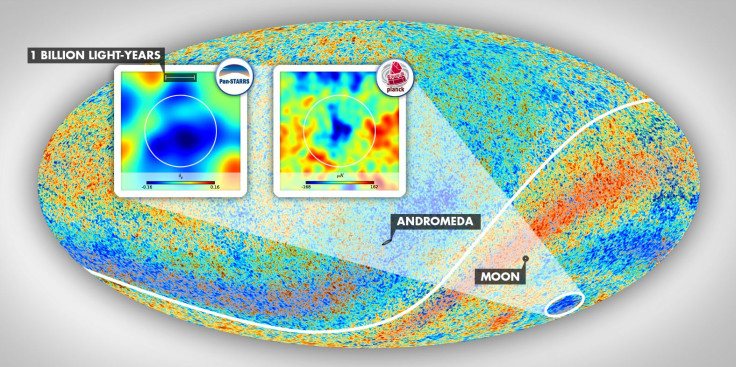Universe's Largest Known Structure Is A 'Supervoid' 1.8 Billion Light-Years Across

Space, as Douglas Adams once observed, is mind-bogglingly big. Given its sheer size, it should come as no surprise that the biggest structure ever detected in the universe is basically an incredibly large chunk of empty space.
Although scientists who discovered this “supervoid,” which is 1.8 billion light-years across, are currently unable to explain why this region of space-time is missing nearly 10,000 galaxies, it could shed light on an equally mysterious problem -- the cosmic microwave background radiation (CMB) cold spot.
The supervoid was detected using Hawaii’s Pan-STARRS1 telescope located on Haleakala, Maui, and NASA’s Wide Field Survey Explorer satellite. Istvan Szapudi from the University of Hawaii, the lead author of the study, said in a statement, that this spherical blob might very well be “the largest individual structure ever identified by humanity.” In fact, some have even claimed that the existence of this supervoid contradicts our current understanding of space-time itself.
Intriguingly, this supervoid is located in the same position as the CMB cold spot, which is a region of the universe located nearly 3 billion light-years from Earth and is unusually large and cold. Although a number of theories -- ranging from parallel universes to instrumental error -- have been put forward to explain this anomaly in the most ancient form of radiation known in the universe, the discovery of this supervoid might just offer the most plausible explanation for its existence.
The latest study suggests that the supervoid may be draining more energy from the radiation traveling through it than normal, more dense space would. This occurs because of a phenomenon known as the Integrated Sachs-Wolfe (ISW) effect.
ISW posits that when light travels into a supercluster, which is a region of the universe with many galaxies and is the exact opposite of a supervoid, it is akin to a ball rolling downhill. As a result, when light enters this region, it heats up and gains energy. When light leaves the supercluster -- millions of years later -- it must climb back “uphill,” losing energy in the process. However, due to the expansion of space-time, this region becomes relatively flatter by the time light exits the supercluster. So, the radiation is unable to lose all the energy it gained while entering. The exact opposite of this process occurs when radiation enters and leaves a supervoid.
This phenomenon can explain why this particular region of the universe is colder than it should be. However, the researchers said, even the cooling effect of the supervoid on CMB does not fully explain the cold spot.
For now, it seems, both the exact physics behind the supervoid and the cold spot would remain shrouded in mystery.
© Copyright IBTimes 2025. All rights reserved.






















